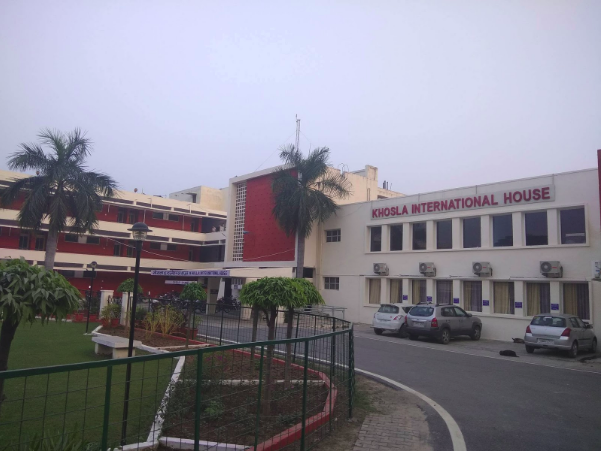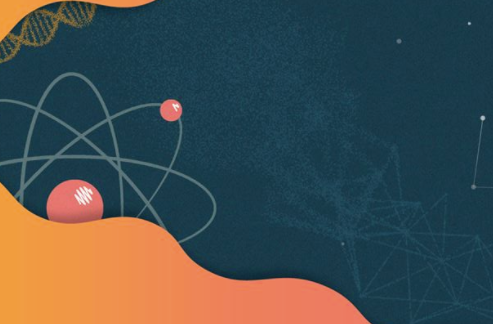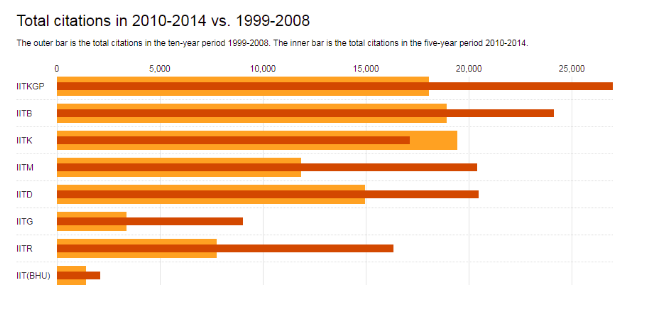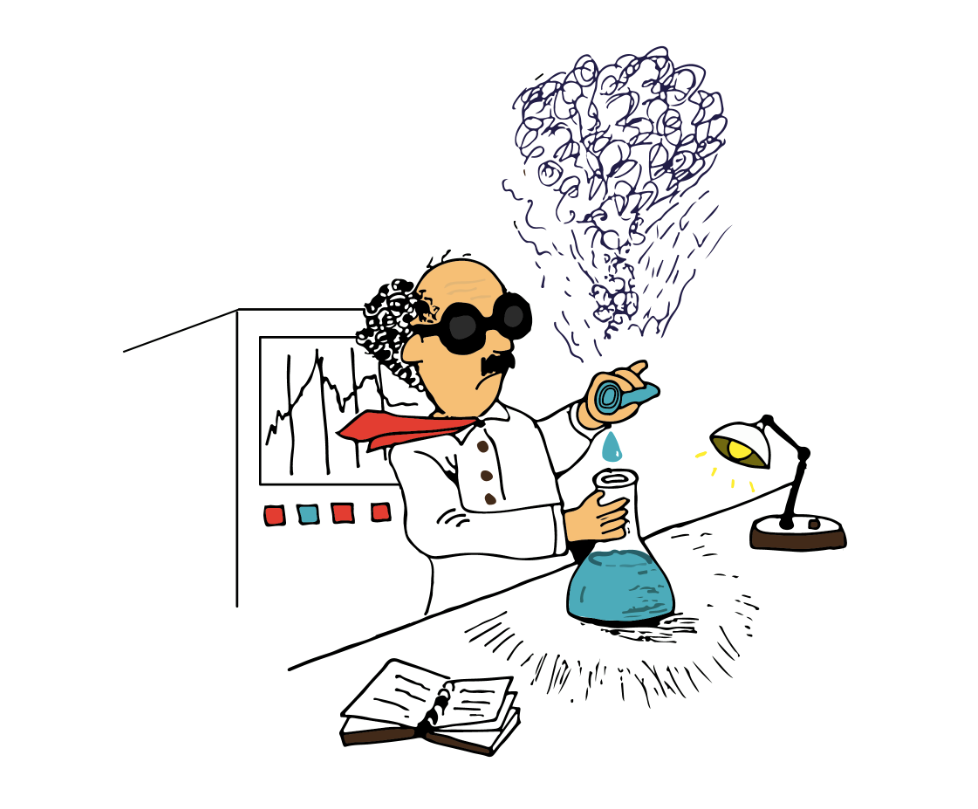

Body of IITR

A long haul of struggle started back in the 1950s with regard to providing scientists and technologists of the highest calibre - who Pandit Nehru supposedly believed would engage in research and development to help steer the nation towards self-reliance in her technological needs. This was the initial ground to set up the IITs - institutes where students would not brawl for placements and packages; an institute where students would actively contribute their mite towards Nehru’s underpinning vision, “Technology”. IITs, despite being the most funded institutes of India, have failed to sail into the global top-200 (except IITD, at 172nd place and IITB at 179th) in QS World University Rankings, 2017-18. In view of this, we tried to explore the research environment in IITs and understand the rationale behind the underperformance of IITs - focusing on IIT Roorkee in particular.
(Skewed results are achieved when Roorkee’s publications before 2010 are accounted for. Roorkee’s age tend to pull the total number of citations into its favor. Thus, the current analysis features publications post-2010.)
As far as the rankings are concerned, Quacquarelli Symonds (QS) World University Rankings, 2016-17, ranked IITR at 431st position, a drop of 32 ranks since last year. We stand 231st in QS Engineering and Technology rankings - a colossal 160 positions short of IITD standing. The research productivity of IITR over the past 5 years has been commendable - we produced an equivalent output on the research front as produced from 1999-2008; the total citations, achieved by Roorkee, in the past 5 years, is double than that in 1999-2008. Although these results show significant improvement, we are still unable to compete with the productivity that our sister IITs boast of. The total research paper output of IITR from 2010-2014 was 3,452 compared to 5,871 of IIT KGP. We produced only 805 Internationally collaborative papers, while IITB’s turnout was an astounding 1470 papers.Per Capita, Roorkee has an average 7.6 publications - IITB, IITD, IITM, IITK, IIT-Kgp have a minimum of 9.7 publications per capita and maximum 10.8.
As shall be sanely argued, the quality of publications matters more than quantity, Roorkee boasts of approximately 16,330 citations for the period 2010-14, a far cry when compared to IITB’s 26,991 citations. As the exhaustive review suggested, IITB also had 85 publications in the top 1% most cited papers for all IITs; IITR achieved only 39 publications.
 Credits : The Wire
Credits : The Wire
This dearth in productivity, as claimed by many professors, stems from the lack of effective UG research in the institute. The recent budget unveiled that Roorkee receives the maximum amount amongst all IITs, and complaints were registered regarding a lack of endowment in the same year.
Although, like many of our sister IITs, we have numerous tie-ups with leading corporate firms - IBM, Adobe, Texas Instruments, to name a few - the administration has failed to give our researchers a world-class environment conducive to quality research. Unavailability of instruments, huge amount of time delay in the repairing of faulty instruments, no proper instructions for operation, tedious process and paperwork for the purchases of new instruments - the hurdles are almost infinite. A study by the renowned magazine, “Science,” shows that around 12% of the US Graduate enrollments were Indians, whilst they comprised only 3% of the Undergraduate enrollments; the author states that, “Top-performing Indian students are well-served at the undergraduate level by the country’s network of elite technology institutes, known as IITs”. It is very obvious that the undergraduate program is just a building block. Undergraduates, however, are never a pillar of research output. Professors, in general, allow them to gain experience by being a part of their groups. Research happens mostly in the Graduate and PhD programmes. The Admission procedure to the way resources are offered - a basic analysis reveals severe loopholes, indeed.
IITs have a linear admission procedure, and are based on a student’s performance in the 3 hours of the GATE examination. It does not have any consideration about what the student has achieved or demonstrated to date. It basically boils down to one’s analytical and capacity for mental math in those three hours.
Although the admission procedure into the post-graduate programme is plain and straightforward, the PhD admissions involve rigorous testing and interviews. Along with clearing minimum GATE cutoff, selection of a particular student depends on the number of vacancies, synchronisation with the research interest of the professor preferred, and how convincing can you be, in your interview. Finally, the fate of all PhD seekers rests at the discretion of the professor, and thus, one’s ability to market themselves becomes decisive. But for an undergraduate from IIT - with a “mighty” CGPA of more than 8.5 - GATE score is not a requisite for admission into PhD programme. The snag in this form of selection lies in the scholarship criteria - without a minimum GATE score, you become ineligible for the Junior Research Fellowship from MHRD, and, subsequently, the Senior Research Fellowship.
On a contrarian note, one gets to observe some very vivid differences when the admission procedurals of reputed institutions abroad are scrutinized. It is imperative to understand why the research environment in reputed US universities is conducive to their greater output - qualitatively and quantitatively.
A student, to begin with, chooses a university, that he/she is interested in applying to. This is based on his/her interests, the professors in the field of interest, and recommendations. Post-GRE and TOEFL results, one is allowed to apply to 4 universities in US. However, one can send their scores to other universities too, with an extra payment. The applications are consequently scrutinized on the basis of SoPs and LoRs (Usually 3 LoRs are needed for US universities). One’s SoP matters greatly. CGPA, publications, patents, the width of the resume are also scrutinized. The procedure for Guide allotment usually varies, however, a generally followed procedure entails a student choosing his/her guide, with the help of a Graduate Advisor, as soon as possible. One is to declare two guides, in an order of priority. At the end of one’s first year of PhD, one is allowed to switch to the second Guide, as listed in the aforementioned declaration.
It is very evident that the US procedure is far more critical of a student’s overall capabilities, his intentions for a MS/PhD, and the synchronicity between the guide and student. Such a system can very well be deployed in the Indian institutes. It shall allow for higher quality of students, and, hence, better research outputs.
Most of the research output from the institute is through the M.Techs and the PhDs. IITR, being one of the premier institutes of the country and having shown high growth in research in past 5 years, nimbly attracts many aspiring candidates. However, their research experience here is blemished by certain predicaments that they have to face while carrying out their research. A common hitch faced by the students is incompatibility with guides. A guide steers the research towards a certain path, and is the person that students turn toward when they are stuck - making it essential that they have a good rapport with him/her. If a guide is uncooperative and passive towards their problems, that certainly does not help matters; it disrupts the flow of work. The process of changing guides is a long one and it may lead to frosty relations between the professors involved.
The department policies are also not very student-friendly either; QIP (Quality Improvement Program), is a program which requires that the students take some prerequisite courses, and gives them a chance to earn some extra credits on the way. Although the idea sounds great on paper, it is not a popular option among the students, because the courses can be irrelevant to their area of specialization. Moreover, the necessity of taking this course is left to the professor’s discretion.
In addition to the above, one also has to deal with issues that plague most of the Indian labs, especially in regards to the inadequacy and obsoleteness of instruments. All the expenses incurred for sending samples to lab testing are borne by the student himself/herself; more often than not, the students are on the receiving end of the professor’s whims and are saddled with the personal tasks of the professors; doctoral research is funded by the MHRD for only 7 years, so, if a student is forced to confront the unfortunate event of being forced to delay his PhD, due to some unforeseen circumstances, he/she is at the mercy of the institute and the professors - most rant by students are not baseless.

Research in the European countries and the US has a hierarchical setup - ensuring a smoother flow of work. There are PhDs working in collaboration with post-docs, who, themselves, report to a guide. In India, though, such a setup is lacking in most labs. Says, Dr. PK Jha, India also lacks competent researchers; Indian researchers are directionless most of the times. What researchers in the Indian context lack, is methodology, efficiency, and result oriented-ness. Most researchers in India publish only for money, and the results are lackluster manipulations and copy-paste jobs. This practice is largely frowned upon in the foreign universities, and considered highly unethical. A common gripe among the professors is the lack of creativity among the Indian researchers; they argue that students bring nothing new to the table.
While the universities in the US are federally funded, the burden of allocating funds to the universities in India falls upon the MHRD. In the present schematic, the IITs are better funded than the state universities, which puts them at a relative advantage when it comes to carrying out quality research. However, a common problem that plagues most of the Indian universities, is that the available resources are mostly digital in nature, with even the print material not being available at times due to financial and spatial constraints.
Moving on to undergraduate research, professors are impressed by the quality of students that approach them for projects in the semester, but strongly feel that the number of students actively pursuing research is minimal. Although programs like SURA (Summer Undergraduate Research Award) are present, not many students opt for them. This may be due to the heavy coding-centric culture that our campus has developed over the past few years. In India, research is still not considered a viable career option. With too much time invested, and lower salaries, there is a strong reason why many students shy away from research. However, they say research abroad is highly incentivised, and students are urged toward making breakthroughs in technology and innovation. Perhaps a paradigm shift in the way students view career options is needed for research to boom in the undergraduate section, they muse. The only undergraduate students from IITs who stay in India for their PhDs are those are motivated by a strong sense of nationalism and giving back to the country.
Talking of undergraduate research, it is a common consensus among professors that while the institute offers ample resources and opportunities to the students to carry out research, they don’t utilize the same. Professors claim that this is not the case with students in the foreign universities. In our institute, in general, and in India, in specific, there is a lot more focus on areas other than research, hence overshadowing the same.
The obvious fallacies in the current systems at the top tier institutions, where promotions are based on the number of research papers a faculty member has published (as opposed to the quality of the work), has lead to a research culture which produces a large quantity of low quality research papers. Furthermore, since teaching is not something that the faculty’s performance is graded on, the quality of teaching seems to be deteriorating at the top institutions, leading to a disinterest among students. While this is not a fault of the faculty, the administration must look toward implementing changes that foster a conducive environment for quality research, and where young minds are nurtured toward research.
While there are lots of causes of worry in the current research scenario, things seem to be shaping up for the better. The past few years have seen a rise in the number of students in R-Land opting for research, and the number of students applying for SURA scholarships at IITR has increased dramatically. Coupled with governmental policies looking to retain outgoing talent by providing higher pay grades to promising undergraduates (via the Prime Minister’s Fellowship Scheme), this will hopefully lead to better quality student-researchers and a higher quality research output, eventually shaping the currently bleak scenario into a brighter tomorrow.
The article features as the Big Story in our next print issue. In the issue’s Cover Story, we take you back in time to the foundation of our institute, and its journey from there on. To read our previous issues visit: here.